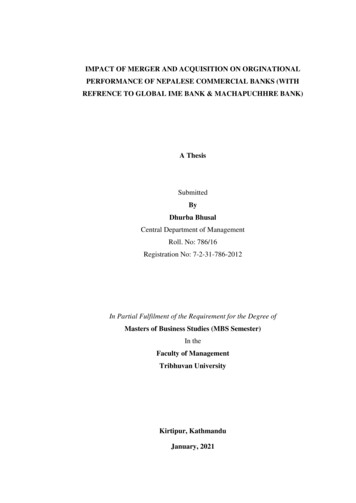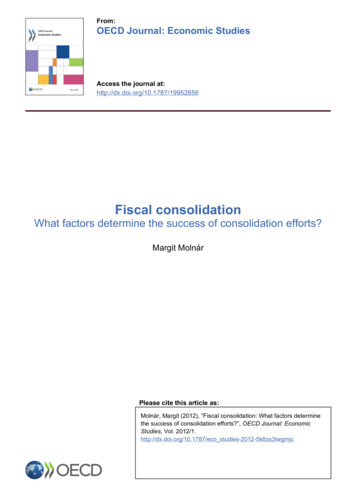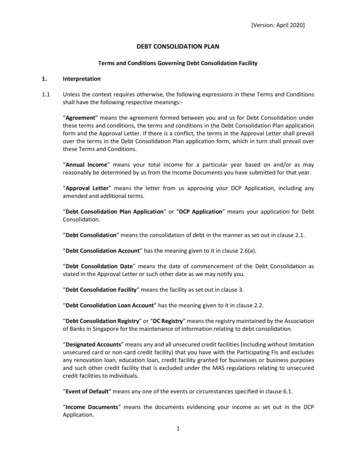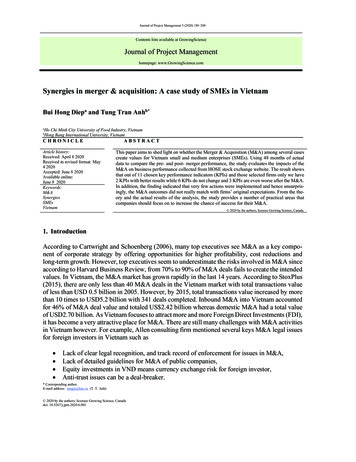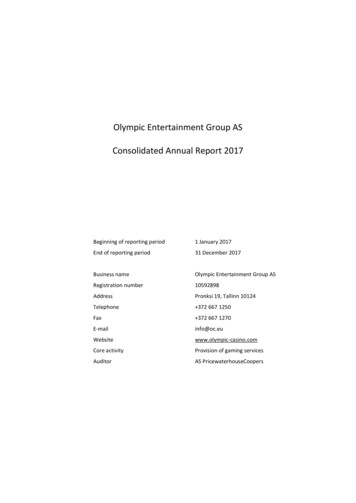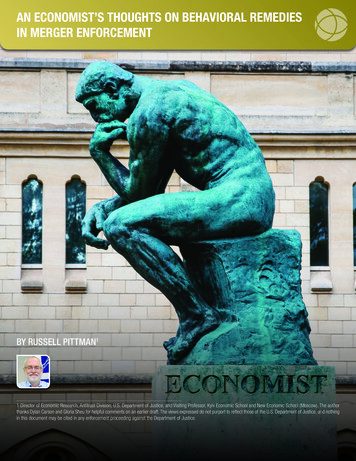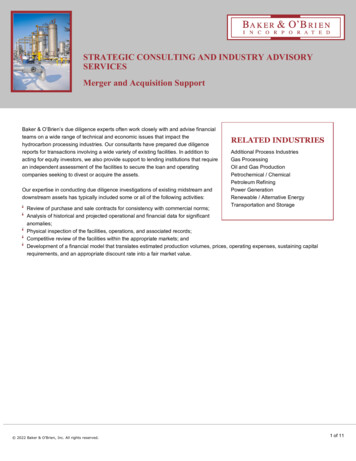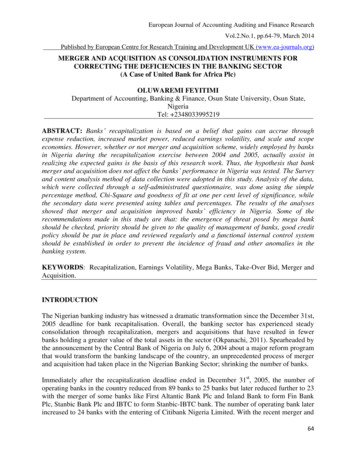
Transcription
European Journal of Accounting Auditing and Finance ResearchVol.2.No.1, pp.64-79, March 2014Published by European Centre for Research Training and Development UK (www.ea-journals.org)MERGER AND ACQUISITION AS CONSOLIDATION INSTRUMENTS FORCORRECTING THE DEFICIENCIES IN THE BANKING SECTOR(A Case of United Bank for Africa Plc)OLUWAREMI FEYITIMIDepartment of Accounting, Banking & Finance, Osun State University, Osun State,NigeriaTel: 2348033995219ABSTRACT: Banks’ recapitalization is based on a belief that gains can accrue throughexpense reduction, increased market power, reduced earnings volatility, and scale and scopeeconomies. However, whether or not merger and acquisition scheme, widely employed by banksin Nigeria during the recapitalization exercise between 2004 and 2005, actually assist inrealizing the expected gains is the basis of this research work. Thus, the hypothesis that bankmerger and acquisition does not affect the banks’ performance in Nigeria was tested. The Surveyand content analysis method of data collection were adopted in this study. Analysis of the data,which were collected through a self-administrated questionnaire, was done using the simplepercentage method, Chi-Square and goodness of fit at one per cent level of significance, whilethe secondary data were presented using tables and percentages. The results of the analysesshowed that merger and acquisition improved banks’ efficiency in Nigeria. Some of therecommendations made in this study are that: the emergence of threat posed by mega bankshould be checked, priority should be given to the quality of management of banks, good creditpolicy should be put in place and reviewed regularly and a functional internal control systemshould be established in order to prevent the incidence of fraud and other anomalies in thebanking system.KEYWORDS: Recapitalization, Earnings Volatility, Mega Banks, Take-Over Bid, Merger andAcquisition.INTRODUCTIONThe Nigerian banking industry has witnessed a dramatic transformation since the December 31st,2005 deadline for bank recapitalisation. Overall, the banking sector has experienced steadyconsolidation through recapitalization, mergers and acquisitions that have resulted in fewerbanks holding a greater value of the total assets in the sector (Okpanachi, 2011). Spearheaded bythe announcement by the Central Bank of Nigeria on July 6, 2004 about a major reform programthat would transform the banking landscape of the country, an unprecedented process of mergerand acquisition had taken place in the Nigerian Banking Sector; shrinking the number of banks.Immediately after the recapitalization deadline ended in December 31st, 2005, the number ofoperating banks in the country reduced from 89 banks to 25 banks but later reduced further to 23with the merger of some banks like First Altantic Bank Plc and Inland Bank to form Fin BankPlc, Stanbic Bank Plc and IBTC to form Stanbic-IBTC bank. The number of operating bank laterincreased to 24 banks with the entering of Citibank Nigeria Limited. With the recent merger and64
European Journal of Accounting Auditing and Finance ResearchVol.2.No.1, pp.64-79, March 2014Published by European Centre for Research Training and Development UK (www.ea-journals.org)acquisition of some of the nine rescued banks i.e the merger of Access Bank Plc withIntercontinental Bank Plc; merger of Ecobank Transnational Incorporated with Oceanic BankPlc; merger of First City Monumental Bank with Fin Bank Plc, the number of banks operating inNigeria will be reduced further.However, in August 2011, the CBN revoked the licenses of three of the rescued banks for failingto show ability to recapitalise ahead of the September 30, 2011 deadline, effectivelynationalizing Bank PHB, Afribank and Spring Bank. The assets of these banks were transferredto three newly created, nationalised banks: Keystone Bank, Enterprise Bank and MainstreetBank. AMCON which took over the banks also injected N680 billion to recapitalise the banks.Unity Bank Plc, one of the bailed out banks has already recapitalised while Wema Bank Plc, thelast of the rescued banks, has since scaled down operations to become a regional bank withemphasis in the south west region.The waves of mergers and acquisitions that had taken place in the Nigerian banking industryraise an important question of whether bank consolidation enhances the financial sector’sperformance in Nigeria. Hosono et al (2007) argues that consolidation may increase or decreasethe performance of a bank. Going by the unfolding events, the post-consolidation performance ofall Nigerian banks was badly hit in 2009 by the global financial and economic crisis, which wasprecipitated in August 2007 by the collapse of the sub-prime lending market in the United States.Nonetheless, Lamido Sanusi (2010) attributed the post-consolidation challenges of Nigerianbanking industry to the inability of the industry and the regulators to sustain and monitor thesector’s explosive growth which as a result led to risk-build in the system.Statement of the problemThe recent outbreak of bank mergers in Nigeria is attracting much attention, partly because ofheightened interest in what motivates firms to merge and how mergers affect efficiency.However, there are often two distinct views to the rationale behind merger and acquisition. Thefirst held view of mergers, especially those involving mega firms, is that firms are merging justto get bigger and not to get more efficient. Accompanying that notion is the fear that as mergingfirms grab greater market share, individual freedoms, competition and efficiency are threatened,because bigger is perceived as greater concentration of power.The second view holds that firm’s merge not just to get bigger but also to be more efficient inoperations and outputs. It is claimed that mergers enable the banking industry to take advantageof new opportunities created by changes in the technological and regulatory environment. Thisstudy shall investigate these two contrasting views by examining the roles played by merger andacquisition in the recapitalization of banks that had taken place in the Nigerian banking sector onthe efficiencies of a selected bank.Objectives of the studyThe purpose of this paper is to examine the efficacy of mergers and acquisitions in the NigerianBanking sector. Thus, this study will also focus on the following micro objectives:1.To critically evaluate the structural and brand implications of the merger and acquisitionoption in the post consolidation era.65
European Journal of Accounting Auditing and Finance ResearchVol.2.No.1, pp.64-79, March 2014Published by European Centre for Research Training and Development UK (www.ea-journals.org)2.3.To identify the motives behind corporate merger and acquisition.To investigate the impact of merger and acquisition on bank efficiency.Research questionsThe study would examine the following questions:1. What are the structural implications of bank merger and acquisition?2. What are the motives behind bank merger and acquisition?3. How do merger and acquisition impact on efficiency?H0:H1:Statement of hypothesisThe hypothesis that would be tested in the course of this research is stated below as:Bank merger and acquisition does not affect the banks’ performance in NigeriaBank merger and acquisition affects the banks’ performance in NigeriaScope of the studyAlthough, a number of bank mergers had taken place since the recapitalisation exercise, themerger between Standard Trust Bank and United Bank for Africa was the least expected andmany were of the opinion that the merger was not to meet the December 31st, 2005 deadline ofthe Central Bank of Nigeria, but fuelled by the need to survive and be a major player in the postconsolidation era in Nigerian banking sector. In carrying out this research work, attention wouldbe focused on the Nigerian Banking Industry with special reference to the merger betweenUnited bank for Africa (UBA) and Standard Trust Bank (STB). Besides, the field survey shall beconducted only in Lagos branches of the new United Bank for Africa (UBA) since this is the citywhere UBA has the largest number of its branches in the world.LITERATURE REVIEWTheoretical PerspectiveWhen the term “merger” is being used, it is referring to the integration of two companies whereone new company will continue to exist. The term “acquisition” refers to the acquisition of assetsby one company from another company. In an acquisition, both companies may continue toexist. However, throughout this study mergers and acquisitions would be loosely referred to as abusiness transaction where one company acquires another company. The acquiring company willremain in business and the acquired company will be integrated into the acquiring company andthus, the acquired company ceases to exist after the merger as in the case of UBA-STB merger.According to Okonkwo (2004), a merger (or an amalgamation) occurs when two or morecompanies transfer their businesses and assets to a new company (or to one of themselves) and inconsideration, their members receive shares in the transferee company. He stated that anacquisition occurs when one company acquires sufficient shares in another company so as togive it control of that other company. He noted that an essential difference between a merger andan acquisition is that in a merger, there is no disinvestment of the shareholders of theamalgamating companies while the reverse is the case in an acquisition. Section 590 of theCAMA (repealed) defined “Merger” as “any amalgamation of the undertakings or any part of theundertakings or interests of two or more companies or the undertakings or part of the66
European Journal of Accounting Auditing and Finance ResearchVol.2.No.1, pp.64-79, March 2014Published by European Centre for Research Training and Development UK (www.ea-journals.org)undertakings of one or more companies and one or more bodies corporate.” In the opinion ofLynch (1997) he said that, mergers usually arise when neither company has the scale to acquirethe other on its own weaker company; expansion can be created by entrepreneur that is alreadyestablished through mergers agreement. He can merge with another company producing similarproducts to form a new strong identity that will be of a greater advantage to both. Gilligan, et al(2002) opined that a banking merger is just the same as the merger of any two companies, exceptthat it involves banks. They noted that it will likely involve one of the following three basicstructures: (a) the acquiring bank (the purchaser) acquires the shares of the target bank (thetarget); (b) the purchaser acquires the business (or part of the business) of the target; or (c) BankA and Bank B enter into a joint venture or shareholders’ agreement whereby Bank A and Bank Bbecome shareholders in a new bank, Bank. They stated that the most significant point in bankingmergers is that the banking activities of the participants will almost always be regulated becausethe institutions use the name “bank”, take deposits or transmit money and so the transfer willneed to be approved and any new entity licensed as a bank.Empirical StudiesA large portion of the empirical work examining the benefits of mergers focuses on changes incost efficiency using available accounting data. Berger and Humphrey (1992) examine mergersoccurring in the 1980s that involved banking organizations with at least 1 billion in assets. Theresults of their paper are based on data aggregated to the holding company level, using frontiermethodology and the relative industry rankings of banks participating in mergers. Frontiermethodology involves econometrically estimating an efficient cost frontier for a cross-section ofbanks. For a given institution, the deviation between its actual costs and the minimum cost pointon the frontier corresponding to an institution similar to the bank in question measures Xefficiency. The authors find that, on average, mergers led to no significant gains in X-efficiency.Berger and Humphrey also conclude that the amount of market overlap and the differencebetween acquirer and target X-efficiency did not affect post-merger efficiency gains. In additionto testing X-efficiency, they also analyze return on assets and total costs to assets and reach asimilar conclusion: no average gains and no relation between gains and the relative performanceof acquirers and targets. Non-interest costs yield significant results, but the findings are oppositeof expectations that the operations of an inefficient target purchased by an efficient acquirershould be improved.Somoye (2008) analysed the published audited accounts of twenty (20) out of twenty five (25)banks that emerged from the consolidation exercise and found that the consolidation programmehas not improved the overall performances of banks significantly and also has contributedmarginally to the growth of the real sector for sustainable development. Okpanachi (2011)conducted a comparative analysis of the impact of mergers and acquisitions on financialefficiency of banks in Nigeria using gross earnings, profit after tax and net assets of the selectedbanks as indices to determine financial efficiency by comparing the pre-mergers andacquisitions’ indices with the post-mergers and acquisitions’ indices for the period reviewed. Thefinding revealed that the post-mergers and acquisitions’ period was more financially efficientthan the pre-mergers and acquisitions period supports this view. Akhavein, et al (1997) analysechanges in profitability experienced in the same set of large mergers as examined by Berger andHumphrey. They find that banking organizations significantly improved their profit efficiency67
European Journal of Accounting Auditing and Finance ResearchVol.2.No.1, pp.64-79, March 2014Published by European Centre for Research Training and Development UK (www.ea-journals.org)ranking after mergers. However, rankings based on more traditional ROA and ROE measuresthat exclude loan loss provisions and taxes from net income did not change significantlyfollowing consolidation. DeYoung (1993) also utilizes frontier methodology to examine costefficiency and reaches similar conclusions as Berger and Humphrey. Cost benefits from mergersdid not exist for 348 bank-level mergers taking place in 1986 and 1987. In addition to the lack ofaverage efficiency gains, improvements were unrelated to the difference between acquirer andtarget efficiency. However, DeYoung does find that when both the acquirer and target were poorperformers, mergers resulted in improved cost efficiency. In addition to frontier methodology,the literature contains several papers that solely employ standard corporate finance measures toanalyze the effect of mergers on performance. For example, Srinivasan and Wall (1992) examineall commercial bank and bank holding company mergers occurring between 1982 and 1986.They find that mergers did not reduce non-interest expenses. Srinivasan (1992) reaches a similarconclusion. The work of Linder and Crane (1992) is also noteworthy. They analyze the operatingperformance of 47 bank-level intrastate mergers that took place in New England between 1982and 1987. Of the 47 mergers in the sample, 25 were consolidations of bank subsidiaries ownedby the same holding company. The authors aggregate acquirer and target data one year before themerger and compare it to performance one and two years after consolidation. The performanceof merged banks is adjusted by the performance of all non-merging banks in the same state as themerging entities. The results indicate that mergers did not result in improved operating income,as measured by net interest income plus net non-interest income to assets. Several studies findevidence of merger gains, but the results of these studies need be scrutinized carefully. Spindtand Tarhan (1993) find gains in their sample of 192 commercial bank mergers completed in1986. Non-parametric tests comparing the performance changes of merged banks with a group ofmatched pairs indicate that mergers led to operating improvements. The results, however, may bedue primarily to economies of scale. The existing evidence in the literature suggests that scaleeconomies do exist for institutions holding less than 100 million in assets. Turning to studies ofstock market reactions to merger announcements, researchers also generally fail to find totalgains from consolidation. Hannan and Wolken (1989) conduct a study of the value-weightedabnormal returns experienced in 43 deals announced between 1982 and 1987. The authors findthat, on average, total shareholder value was not significantly affected by the announcement ofthe deal. The authors do, however, find that one determinant, target capitalization, crosssectionally influenced expected synergistic gains. Target capital was negatively related to thechange in total value. Houston and Ryngaert (1994) examine abnormal returns from four daysbefore the target was initially declared a takeover candidate (by any bank) to the announcementday. In their sample of 153 mergers announced between 1985 and 1991, acquirers suffered a lossin value and targets enjoyed a gain. However, there was no significant aggregate effect on theoverall value of the two organizations. The amount of value that was created was highest whenacquirers were strong pre-merger performers and when substantial overlap existed. Thisrelationship of value creation with the degree of overlap is consistent with the market expectingmergers best suited for improved efficiency and/or increased market power to experience thegreatest level of post-merger benefits. Madura and Wiant (1994) study abnormal returns ofacquirers over a lengthy period following the merger announcement. They find that averagecumulative abnormal returns of acquirers in a sample of 152 deals taking place between 1983and 1987 were negative during the 36-month period following the merger announcement.Moreover, abnormal returns were negative in nearly every month. Acquirer losses around the68
European Journal of Accounting Auditing and Finance ResearchVol.2.No.1, pp.64-79, March 2014Published by European Centre for Research Training and Development UK (www.ea-journals.org)time of the announcement may reflect a loss of wealth from an overly generous acquisition price.Negative abnormal returns in months after the announcement , however, are not likely to be dueto the price. They seem more attributable to either the merger achieving fewer benefits thanprojected, or the market revising downward its expectations for the merger. Recently, severalpapers incorporate both approaches in the literature. The first of these studies is conducted byCornett and Tehranian (1992) and examines 30 large holding company mergers occurringbetween 1982 and 1987. The authors find that profitability, as measured by cash flow returns onthe market value of assets, improved significantly after the merger. This finding, however, mustbe viewed closely for several reasons. First , the market value of assets may be an inappropriatemeasure for standardizing income. It is defined primarily from the liability side of the balancesheet as the market value of common stock plus the book value of long-term debt and preferredstock less cash. Given the nature of banks as financial intermediaries, it is unclear why depositsare not included in this liability-based definition. The appropriateness of subtracting cashholdings is also debatable. In summary, most studies fail to find a positive relationship betweenmerger activity and gains in either performance or stockholder wealth. This conclusion of noeconomic benefits holds across a wide variety of methodologies, samples, and levels of analysis,(individual bank or bank holding company). Moreover, there appears to be no relationshipbetween changes in value at announcement and subsequent outcomes.Brand and Structural Implications of Nigerian Banks MergerThe consolidation process within the Nigerian financial sector had a number of effects andimplications. These effects and implications can be broken into 2 broad categories as Brandimplications and Structural implicationsBrand ImplicationsTypically, differentiation in the financial sector is determined by financial might and capitalbase. However, with the consolidation, this differentiation factor gradually becamecommoditised. This is because more banks, such as Guaranty Trust and Zenith, will possessmore financial might bringing them closer to the established banks (e.g. First bank). These seriesof acquisitions will also ensure that the gap in size (branch network is greatly reduced). In viewof this, differentiation in the unfolding financial sector will be greatly impacted upon by thestrength of a bank’s brand within the market place, and not just the size of its balance sheet. Thecurrent situation in the market attests to this. Banks with strong brands (i.e. First bank, GuarantyTrust Bank and Zenith Bank) are attracting a lot of attention and may most likely serve as leadbanks in the post-consolidation era. On the other hand, banks with weak brands faced an uphilltask. They became devalued and were forced to merge or be acquired by stronger banks. Thenew entities that had risen from the dust of consolidation will need to deal with brand relatedissues, if they are to survive in the long term. Some of the most critical issues are as follows:a) Change of name: The financial sector has witnessed a lot of name changes within the last fewmonths. A number of names that we were familiar with have cease to exist. The name of anorganisation is its primary token of identification in the marketplace. Thus, organisationsresulting from the consolidation process were faced with two options: a. Adoption of the nameof the organisation with the strongest brand name (this is often the case if the situation is anacquisition). b. Adoption of a new name (more common with mergers). Whatever approachtaken, the introduction of the name of the new entity must have be done in such a way that the69
European Journal of Accounting Auditing and Finance ResearchVol.2.No.1, pp.64-79, March 2014Published by European Centre for Research Training and Development UK (www.ea-journals.org)brand equity resident in the names of the organisations involved was not lost but leveragedadequately (because each of the names already has certain associations and implications).Careful consideration must have been given to what the association’s new name would evoke inthe market. Therefore, it is important that a strategic approach had been applied in thedevelopment of the name because of its importance to the brand.b) Change of logo: In addition to name changes, a number of new logos have been unveiled asthe mergers & acquisitions spree lasted. The word logo is derived from the Greek word ‘Logos’.The logo of an organisation is its graphical mark of identity in the market. It is thereforeimportant to ensure that like the name, the logo for the entity resulting from a merger oracquisition scenario takes into consideration the brand equity resident in the constituentorganisations. Such equity may be in the form of colours or symbols. For example, oil giant,British Petroleum (BP Plc) wanted to revamp its brand after its merger with Amoco in 1998 andthe further acquisition of two other oil companies, Arco and Castrol in 1999 & 2000respectively. It settled for the strongest name in the group of companies i.e. BP. It alsomaintained BP’s colour palette of green and yellow as the corporate colour because it wasconsidered a brand asset and unique in the petroleum sector. Another example is the mergerbetween Citibank and Traveller’s Group. The merged firm was named Citigroup. AlthoughCitibank was the smaller of the two, it was the stronger brand. Citigroup incorporated Citibank’scorporate colour - blue and a key element of the Traveller’s group logo - the red umbrella - intothe Citigroup logo. On the other hand, France Telecom’s departed from its staid logo andsymbols because it wanted to communicate an entirely new concept as it metamorphosed from astate-owned monopoly into a free market competitor. The new logo, an ampersand, symbolisedthe “bringing together of people and the decision by the company to never go out of style.” Themerger between UBA and STB has retained the name UBA because of its strong identity overthe years while the logo of STB has been adopted as a symbol of innovation and customer focusservices for which the bank was known for. In the same vein, some of the other consolidatedentities in the banking sector also signified an entirely new concepts and strategic directionthrough the change of their logos. The design of a logo for an organisation is not primarily adesign function but a strategic function. Also, as a result of the new logo, it will be necessary toredesign the corporate function and visual identity materials (letterheads, business cards, identitycards, account opening booklets, cheque books, websites, etc) for the new entity.c) Brand culture: Perhaps the most important determinant in the progression of the new banksthat have emerged from the merger and acquisition process is how well the culture of the variousconstituent banks can be melded into one unique cultural system. If this is not properly done, theresulting banks will experience cultural clashes among employees. Every organisation has itsown distinct way of life and its own way of doing things; this is what culture is all about. It islike an invisible hand that guides the thoughts and actions of employees. If a unique culture isnot developed for the new brand, then the battle is over before it begins. It is interesting to notethat in most of the mergers that had been witnessed in the Nigerian financial sector; the focushad been on meeting the required minimum capitalization and not the organizational culture. Theresulting entity will only progress as far as critical brand issues like culture have been resolved.d) Brand message: At the end of the merger or acquisition process, a critical brand issue thatwill arise is “what message will the new entity put out into the market?” It is a safe assumptionthat each of the institutions that make up the new entity touted a particular message. But now thatthey are one, what should they be saying? It is critical that the organisation presents a clear and70
European Journal of Accounting Auditing and Finance ResearchVol.2.No.1, pp.64-79, March 2014Published by European Centre for Research Training and Development UK (www.ea-journals.org)consistent message. This message will determine what the brand will become known for overtime. An effective brand message must find its basis in the essence of the brand.e) Communication: A major consequence of the consolidation of the banking sector will be anincreased effort by banks to propagate themselves within the market place. For this to beeffective, it must be based on more than just a need to put out information on the new entity. Itmust be a strategic initiative that communicates the essence of the brand and its strengths andcompetencies (both quantitative and qualitative). Communication issues are critical and must betackled properly, or else all the organisations will begin to sound alike.Structural ImplicationsIn addition to the aforementioned brand expectations, the current consolidation of the bankingsector will leave in its wake a number of structural issues. These are issues that have directimpact on staff, customers and the structure of the entire banking sector.1. Reduced number of banks: One of the major expectations of CBN and a definite outcome ofthe consolidation within the financial sector and which has been achieved is the reduction of thenumber of banks within the sector from the 94 to 22 banks as at October 1st 2011. A similarsituation occurred in the consolidation of the Malaysian banking sector in the early 90s, wherethe number of banks reduced to 10 banking groups from 54 local banks.2. Increased competition: The entities resulting from the consolidation of the Nigerian financialsector are now bigger (in terms of size, capability and financial might) and thus, be able tocompete more aggressively in the market. Also, because the number of banks has beendrastically reduced, more opportunities may be available to the evolved banking groups.3. Emergence of the Princes (New contenders): Taking a lead from the above, in addition toincreased competitiveness within the sector, the rule of the established banks may be coming toan end and new contenders may arise. Front runners for the crown are Guaranty Trust Bank andZenith Bank. Each of these banks has been able to acquire billions of Naira through IPOs andpublic offers. Consider that Guaranty Trust Bank currently has a capitalisation of N34b againstFirst bank’s N99b, while Zenith has N90b. When the dust from the spate of mergers settles,additional contenders may yet emerge.4. Acquisition digestion issues: In a merger scenario, a critical issue is how the constituentorganisations integrate their operations and processes. The need to integrate operationseffectively will lead to the following: a. Loss of jobs: This will occur from the middle level toexecutive level due to overlaps and duplication of functions within the system. b. Consolidationof branch locations: In a situation where the resulting entity possesses more than one branch in aparticular location, these branches may be coalesced into a singular entity. This will help reducecost overheads and duplication of functions. That is unless the banks want to use the clusteringscenario favoured by Starbucks, Zenith Bank and The Redeemed Christian Church of God. c.Tackling of inefficiencies and bureaucracies: Size creates a certain level of inefficiency andbureaucracy within systems. The new banks will be combinations of three or more banks.Therefore issues of inefficiencies m
2. To identify the motives behind corporate merger and acquisition. 3. To investigate the impact of merger and acquisition on bank efficiency. Research questions The study would examine the following questions: 1. What are the structural implications of bank merger and acquisition? 2. What are the motives behind bank merger and acquisition? 3.


